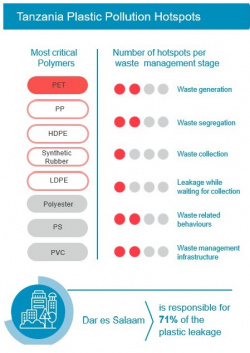Tanzania National Guidance for Plastic Pollution Hotspotting Report: 29 thousand tonnes of plastic leaked to ocean, rivers and lakes in 2018 –proposed solutions to close the plastic tap
The overall aim of Plastics and Coastal Communities (PlastiCoCo) project is the generation of knowledge on plastic pollution (source, distribution, accumulation points and impacts) and identification of mitigation actions along the African Indian Ocean coast.

Photo: © Arena Recycling Industries
In March 2021, a validation workshop was held in person and virtually via Zoom. The workshop brought together over 40 relevant stakeholders from the Government, private sector, academia, research, NGOs, local enterprises and development partners to provide feedback and discussion on the results of IUCN’s Tanzania National Plastic Pollution Hotspotting and Shaping Action report and to share three case studies focused on Circular Economy in Tanzania – for the project Plastics and Coastal Communities (PlastiCoCo).
The overall aim of PlastiCoCo is the generation of knowledge on plastic pollution (source, distribution, accumulation points and impacts) and identification of mitigation actions along the African Indian Ocean coast. Though PlastiCoCo was focused solely on Tanzania, the assessment here is complementary to another IUCN plastic pollution project, Marine Plastics and Coastal Communities (MARPLASTICCs) which is funded by Sweden (Sida) and has generated assessments in Kenya, Tanzania, Mozambique, South Africa.
- A regional plastic pollution analysis identifying the main plastic pollution hotspots
- A guide to possible interventions to mitigate the hotspots structured around the plastic value chain
- Three case studies detailing existing and successful local solutions for potential duplication along the plastic value chain
The objectives of the validation workshop where to share the National Plastic Pollution Hotspotting and Shaping Action Report for Tanzania, to present and discuss the report’s results, Interventions and Instruments for decision making, and to share best practice and lessons on a circular plastics economy from three Tanzania local enterprises.
Speaking at the launch, the Senior Environment Officer of National Environment Management Council (NEMC), Mr. Romanus Tairo on the behalf of the Director General of National Environment Management Council acknowledged the challenges of plastic pollution, including plastic leakage to Tanzania’s coastal and marine environment. He revealed that this is a challenge the government is working diligently to address and NEMC has developed the necessary policy and legal frameworks for the management of the environment including plastic pollution.
This presentation of research results demonstrates in detail the plastic pollution hotspotting data for polymers, sectors, applications, waste management and regional areas in Tanzania that were discovered from the use of the methodology presented in the UNEP/IUCN National Guidance for Plastic Pollution Hotspotting and Shaping Action. Instruments and interventions for action are also shared for consideration by decision makers to address plastic pollution.
Key take-aways from the research in Tanzania include:
- 315 thousand tonnes of plastic waste were generated in Tanzania in 2018.
- Per capita plastic waste generation is around 5.6 kg/year which is lower than the world average of 29 kg/year.
- It is estimated that only 34% of the plastic waste is collected.
- Because there are no sanitary landfill and incineration facilities, there is no proper disposal of waste in Tanzania.
- 95% of the plastic waste is mismanaged and can potentially leak to the oceans, rivers and lakes of Tanzania.
- 29 thousand tonnes of plastic leaked to ocean, rivers and lakes in 2018 in Tanzania.
As shown in Figure 1 below, the most critical polymers found in Tanzania were PET, polypropylene, high-density- and low-density polyethylene. Waste management across the entire country is the primary focus of interventions and methods for addressing the plastic leakage.
 Photo: IUCN
Photo: IUCN
 Figure 2. This figure takes Figure 1 and places it into context for the entire county and shows the 2018 Global View of Plastic Pollution in Tanzania, Plastic Pollution Hotspots in Tanzania and Actions and Interventions Proposed. From IUCN/ EA QUANTIS, 2020, National Guidance for Plastic Pollution Hotspotting and Shaping Action, Country Report Tanzania
Photo: IUCN
Figure 2. This figure takes Figure 1 and places it into context for the entire county and shows the 2018 Global View of Plastic Pollution in Tanzania, Plastic Pollution Hotspots in Tanzania and Actions and Interventions Proposed. From IUCN/ EA QUANTIS, 2020, National Guidance for Plastic Pollution Hotspotting and Shaping Action, Country Report Tanzania
Photo: IUCN
Interventions proposed for Tanzania include
|
Intervention Class |
Priority Intervention |
|
Sustainable Consumption and Lifestyles |
|
|
Waste Collection Systems |
|
|
Waste Infrastructure |
|
Key outcomes of the validation workshop were:
-
Stakeholders obtained a shared understanding of the National Guidance for Plastic Pollution Hotspotting and Shaping Action Report for Tanzania
-
Validation of the National Guidance for Plastic Pollution Hotspotting report content
-
The data, results, and lists of Interventions and Instruments presented in the report were discussed by the participants and have been included in the Africa Regional Report covering Kenya, Mozambique, South Africa and Tanzania. The Regional Report will be presented, in part, at the Nairobi Convention Science and Policy Meeting in March 2021, and published in June 2021.
-
Best practices and lessons learnt on circular plastics economy were also shared with the three presentations from local enterprises
Arena Recycling
EcoAct Tanzania
PREYO Recycling
 Photo: IUCN
Photo: IUCN



